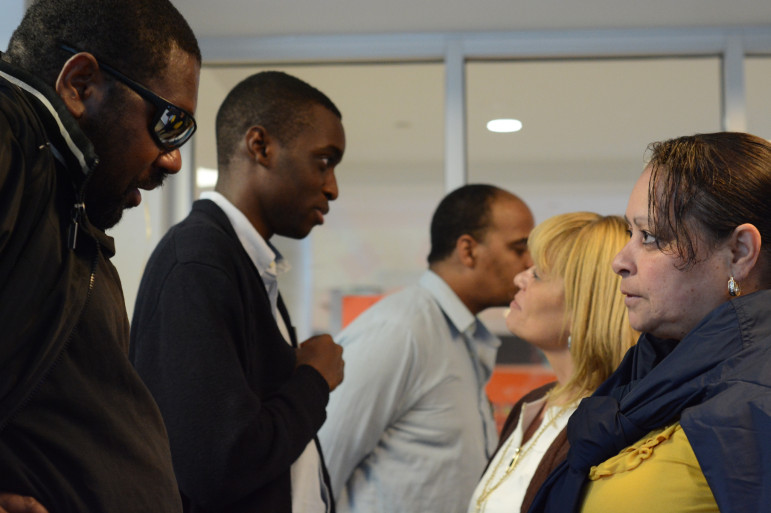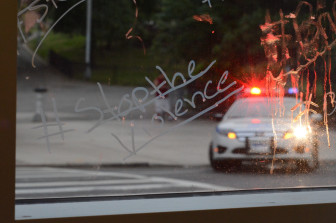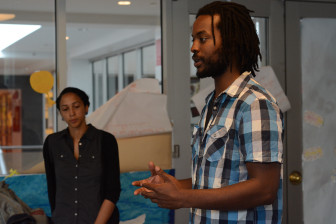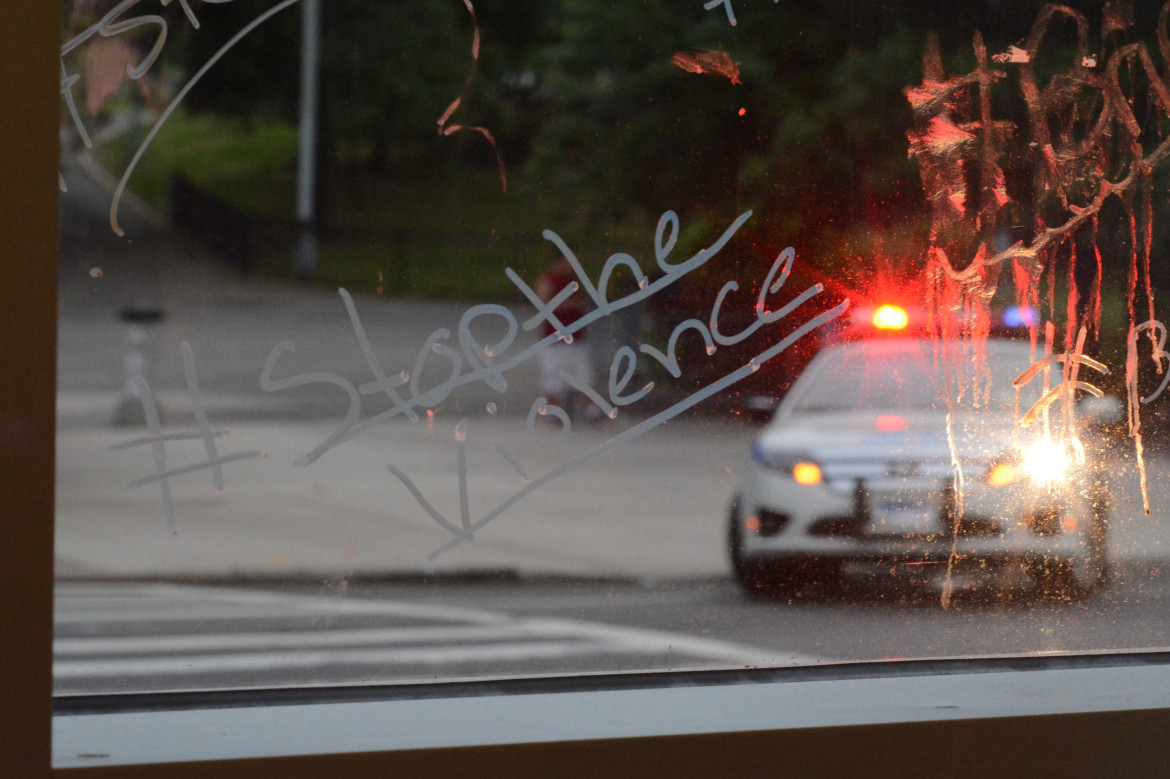
Gwen McClure / JJIE.org
Workshop participants role-play how to interact with police when they are stopped in the community.org
NEW YORK — At first glance, the classroom in the Betances Community Center in the South Bronx last night appeared like a typical children’s classroom. A stuffed lion with a smile sewn into his mouth sat atop an emergency aid kit. A paper cut-out of a grinning fish held a sign with a self-esteem boosting message. Finger paintings of hearts on construction paper faced out from the window.

Gwen McClure / JJIE.org
A police car, seen through the window of Betances Community Center as it leaves St. Mary's Park in the Bronx, New York
But the lesson plan projected onto a screen revealed a different sort of education. True or False: If a cop asks you a question you have to answer.
“Answer ‘False,’” barked Divad Durant, 27, one of the volunteers from the Justice Committee who was leading the session of the Beat the Heat Know Your Rights training session. “Cops are always allowed to talk to you and ask you questions. However, you never have to answer their questions.”
“I knew that,” joked one woman in the audience. “I watch ‘Law and Order.’”
For three hours last night, a small group of men and women ranging in age from the teens to the 50s came to participate in a peculiar curriculum where the syllabus detailed how to exercise your rights during encounters with the NYPD, how to avoid escalating the situation and ultimately how to walk away safely from an encounter. Part theater, part sociology and part street smarts, the session was a crash course in the law as it plays out in real time on the chaos of a city street instead of in the calm of a courtroom.
Read more of JJIE's coverage of this developing story here.
Durant and Josephine Blount, an investigator with the Bronx Defenders Office and Durant’s partner on Cop Patrols, led the session, introducing a mix of True and False quizzes, role playing and open discussions between participants and the workshop leaders about their contentious interactions with the NYPD.
One of the themes of the presentation is what Blount and Durant described as the chasm between the promise of rights and the reality of how they can play out on the street. They talked about what a resident’s rights are at every step of an interaction with a police officer, everything from what qualifies as probable cause and what meets the the reasonable suspicion standard to the distinction between a “frisk” and a “search.”

Gwen McClure / JJIE.org
Divad Durant (right) and Josephine Blount (left) from the Justice Committee lead discussions on how to react when stopped by the police.org
One of the projections on the screen provided examples of what does and does not qualify as reasonable: “Furtive movements, walking back and forth in front of a bank, walking down the street at 3 a.m. with a TV.”
“Being black and standing on the corner or being trans and out late are not examples of reasonable suspicion.”
“We recommend you act like a statue,” Blount said, addressing the class. “Statues remain still. They don’t make any quick movements. Remember, we are dealing with a person who is legally allowed to carry and use a gun. We want to get you out of this situation as quickly as possible.”
Although it had already been scheduled for months, the participants in the workshop said Javier Payne, a 14-year-old who sustained critical injuries when he was smashed through a window during a routine arrest on the night of May 17, was on their mind.
 Many who attended said the need for a workshop like this underscored how troubled the relationship between black and Latino youth is, and how sessions like this give teenagers a vocabulary of rights rather than rage in their dealings with the NYPD.
Many who attended said the need for a workshop like this underscored how troubled the relationship between black and Latino youth is, and how sessions like this give teenagers a vocabulary of rights rather than rage in their dealings with the NYPD.
Hiawatha Collins, 56, said the only thing that surprised him about the Payne incident was how young he was. He said he expects older teens of color to get that treatment.
“It’s no good,” said Collins, who wanted to be an officer as a boy. “They need to rebuild the relationship between the youth and the police department because there’s no trust at all. They live in fear and that’s a shame.”
 Willis Rattigan Cayetano said he has never been arrested, been stopped or seen the inside of a police precinct. He said he is sympathetic to the tough position the police department is in. But he said he understands the frustration black and Latino youth have in their dealing with police.
Willis Rattigan Cayetano said he has never been arrested, been stopped or seen the inside of a police precinct. He said he is sympathetic to the tough position the police department is in. But he said he understands the frustration black and Latino youth have in their dealing with police.
He recommended teenagers like himself attend meetings like this. He said he thinks so many teenagers feel like they are so helpless when it comes to the police that the only response is to meet aggression with aggression.
“I think if Javier had come to this workshop he wouldn’t have been thrown through that window,” said Rattigan Cayetano, who hopes to join the military when he graduates from Evander Childs High School next month, and then go on to law school. “A lot of us teenagers are not aware and knowledgeable about our surrounding, and it’s hard to express ourselves. Learning about your rights lets you express yourself in a different way.”
As a young person growing up in the Parkchester neighborhood of the Bronx, Durant said, he wasn’t a victim of police violence, but that he regularly witnessed his friends get harassed.
“I think it’s a very tension filled relationship that young persons of color from communities of color have with the police department,” he said. “They have no job opportunities, they have no space to go that is safe, they are seeing their educational budgets cut. They are cornered. When they have no opportunity they become subject to criminalization.”
Neilia McKenzie, 23, said she has has sympathy for how challenging an officer’s job is. She said, still, what happened to Payne is inexcusable.
“He’s a young kid, no one deserves that,” she said of Payne. “I think it was sad that it even happened.”
McKenzie, 23, attended a Citizens Police Academy where she learned how police see the world.
“I’m trying my best to be fair and look at it from both sides,” she said. “I don’t think the relationship is very strong. A lot of young people who live around here see the NYPD as the bad guys. I don’t. I know that there are a lot of good cops. But a lot of young people don’t feel the same way.”
Financial supporters of The JJIE may be quoted or mentioned in our stories. They may also be the subjects of our stories.

